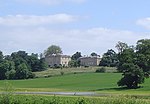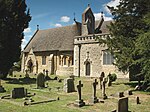Old All Saints Church, Nuneham Courtenay
1764 establishments in EnglandChurch of England church buildings in OxfordshireChurches completed in 1764Churches preserved by the Churches Conservation TrustGrade II* listed churches in Oxfordshire ... and 2 more
Greek Revival church buildings in the United KingdomNeoclassical church buildings in England

Old All Saints Church, or Harcourt Chapel, is a redundant Church of England church near the village of Nuneham Courtenay, Oxfordshire, England. It is recorded in the National Heritage List for England as a designated Grade II* listed building, and is under the care of the Churches Conservation Trust. The church is southwest of the village, in the grounds of Nuneham House overlooking the River Thames, some 6 miles (10 km) southeast of Oxford.
Excerpt from the Wikipedia article Old All Saints Church, Nuneham Courtenay (License: CC BY-SA 3.0, Authors, Images).Old All Saints Church, Nuneham Courtenay
Lower Radley, Vale of White Horse
Geographical coordinates (GPS) Address External links Nearby Places Show on map
Geographical coordinates (GPS)
| Latitude | Longitude |
|---|---|
| N 51.6805 ° | E -1.2182 ° |
Address
Old All Saints Church
Lower Radley
OX14 3AY Vale of White Horse
England, United Kingdom
Open on Google Maps








